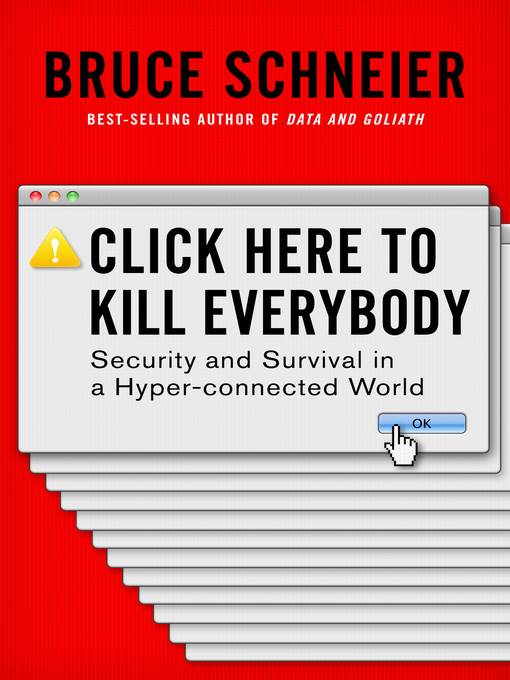
Click Here to Kill Everybody
Security and Survival in a Hyper-connected World
کتاب های مرتبط
- اطلاعات
- نقد و بررسی
- دیدگاه کاربران
نقد و بررسی

September 3, 2018
Schneier (Data and Goliath), a fellow at the Berkman Center for Internet and Society at Harvard University, provides a clear perspective on the threat posed by the evolution of the internet into what is commonly referred to as the “internet of things.” As “everything is becoming a computer... on the Internet,” with even pedestrian items such as light bulbs or refrigerators collecting, using, and communicating data, the convenience and efficiency of such “smart” technology comes at the cost of increased vulnerability to the schemes of crafty hackers. Horror stories, such as a vehicle’s controls being taken over remotely, are not new, but Schneier’s vast experience enables him to tie together many strands and put them in context. For example, after discussing the inherent security issues with software (there are “undiscovered vulnerabilities in every piece”), Schneier goes on to observe that such flaws are only part of the problem; he convincingly demonstrates that a major, if not the main, reason, for an insecure internet is that its “most powerful architects—governments and corporations—have manipulated the network to make it serve their own interests.” Schneier concedes that his book has “a gaping hole” in not explaining how his nuanced recommendations for increasing security and resilience could become policy, but it is a useful introduction to the dimensions of the challenge.

Big Brother is watching and scheming and up to no good--and, writes security technologist Schneier (Data and Goliath: The Hidden Battles to Collect Your Data and Control Your World, 2015), it looks like he's winning.By way of an opening gambit, the author posits three scenarios in which hackers take over machines and computer systems, from printers to power plants, both to demonstrate their ability to do so and to show how the interdependence of the web can easily be put to work against us. In one of those scenarios, real-world to the core, Russian hackers came into a Ukrainian power plant through a malware backdoor, "then remotely took control of the center's computers and turned the power off." That's not just a threat to life, but it also erodes trust in social and economic systems, the basis for civil society. In another scenario, which gives the book its title, a "bio-printer" is hacked to "print a killer virus"--and does. Given all this, why don't the governments and corporations of the world band together to do a better job of cybersecurity? Because, Schneier answers, there are powerful forces that thrive on the "wicked problem" of cybersecurity and insecurity, for one thing; for another, "big companies with few competitors don't have much incentive to improve the security of their products, because users have no alternative." With due pessimism, the author argues that individuals must do their best to harden their own security even as governments battle against encryption, anonymity, and other security measures by claiming that the "Four Horsemen of the Internet Apocalypse--terrorists, drug dealers, pedophiles, and organized crime"--will be the ultimate beneficiaries of secure systems. On a larger level, Schneier proposes resilient systems that provide multiple defensive layers as well as reform of international laws and the establishment of protocols for enhanced protection against the real bad guys.Useful for an internet user but particularly for those concerned with privacy, civil liberties, and related issues.
COPYRIGHT(2018) Kirkus Reviews, ALL RIGHTS RESERVED. (Online Review)

October 1, 2018
Seasoned technologist and security writer Schneier's (Data and Goliath; Liars and Outliers) work springboards from the "Internet of Things" (IoT), or the network of physical devices including cars, electronics, machinery, that connect to one another and exchange data. For this work, the author coins the term Internet+, taken to mean "the Internet + Things + us." By offering a broad introduction to the concept, Schneier aims to familiarize readers to topics and issues surrounding it and to draft a road map toward solutions. Such an approach is challenging; the introductory chapters address IoT concerns that more informed readers may already be aware of, whereas the later, more technical chapters are too specialized for general audiences. Readers who enjoyed Andrew Blum's Tubes: A Journey to the Center of the Internet will be similarly intrigued by Schneier's close study. VERDICT This detailed introduction to Internet+/IoT educates new readers about the domain while offering heavier content for those more familiar with network security topics.--Esther Jackson, New York Botanical Garden
Copyright 2018 Library Journal, LLC Used with permission.

























دیدگاه کاربران